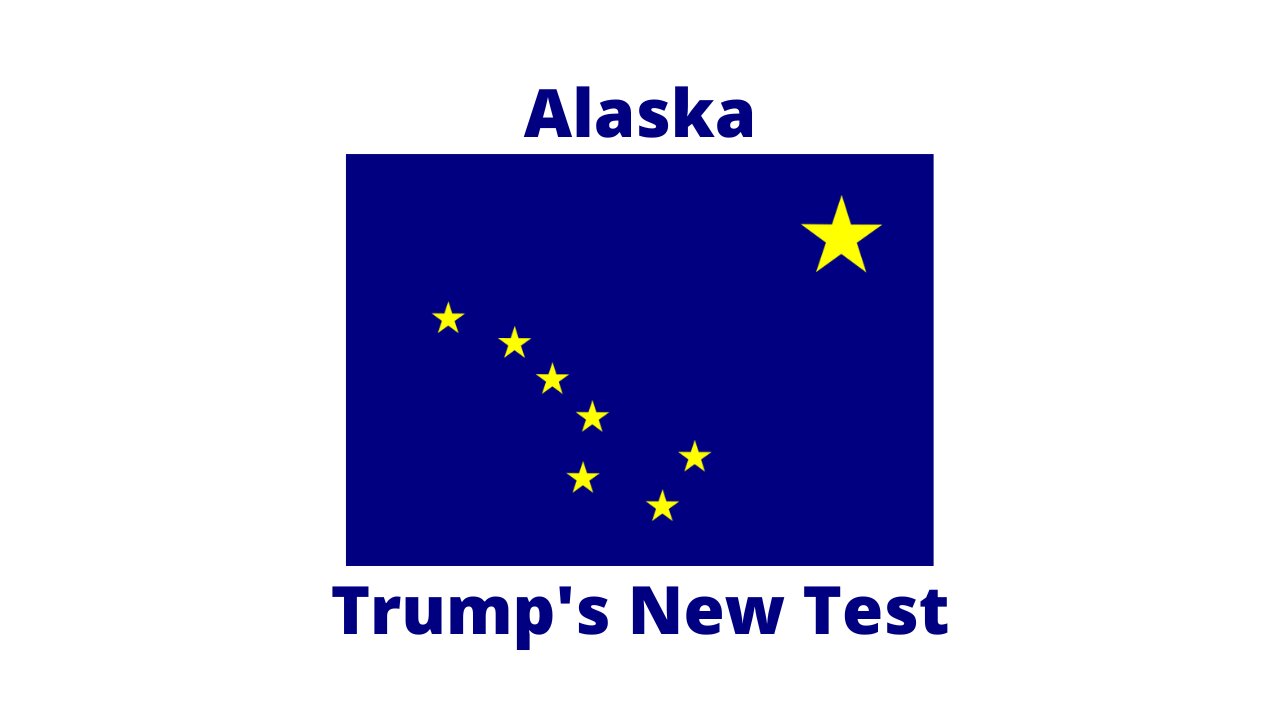Premium Only Content

Alaska – new test of Trump’s power
Alaska – new test of Trump’s power
By Terry A. Hurlbut
Primaries took place in more than one State on August 16. Wyoming held its primaries, and those who voted in them, definitely settled them with majority votes. Alaska is another matter altogether, for Alaska has rolled out a new way to ensure majorities. And perhaps those who promoted that new way, might regret it, at least in part. In fact, if the tentative results hold, the Trump machine will have its most challenging test – but also another chance.
Latest in Alaska from Decision Desk HQ
As before, results in Alaska come from Decision Desk Headquarters, the election-results pool for the Mainstream Media. But unlike the Wyoming case, Alaska’s results are far from complete. Alaska actually ran two elections on August 16. It held a special election for Alaska’s At-large House seat, after Rep. Don Young (R-Alaska) died in March. Alaska also held primaries for its Class III Senate seat, a regular At-large House race, and the governorship.
But Alaska today does not hold separate Republican and Democratic primaries. They have gone in part to the Open Primary system of States like Washington and California. The top four vote-getters in these primaries advance to a unique kind of general election that uses Ranked Choice Voting.
What is Ranked Choice Voting?
Ranked Choice Voting is the latest invention to avoid runoffs and eliminate vote-splitting. Traditionally, a candidate might win a plurality only because voters, having a choice between two or more candidates who promise to govern in a manner opposite the eventual winner, split their votes between those others. In fact that’s how Gaius Julius Caesar became Pontifex Maximus in the year of the Consulship of Cicero and Antony the Proud (63 BC). Caesar ran for P.M., and no fewer than three candidates ran against him. Those three split their vote, and Caesar won.
To avoid this kind of result, voters in Ranked Choice Voting state their first, second, third, and other choices. The process calls this event Round One. Round Two must wait until all precincts have reported their results—a vastly more complicated process. Round Two eliminates the bottom vote-getter and distributes the second choices by those voting for him among the remaining candidates. The next round repeats the process, except that third choices might now be necessary with the elimination of two candidates. The rounds continue until two candidates remain, or until any candidate gets a majority (fifty percent or more).
The Republican Party of Virginia nominated its candidates for the top three executive positions using Ranked Choice Voting. It might not have achieved the best results, for reasons CNAV will explain.
Special election: Ranked Choice Voting Round One
Alaska is holding its special election to fill the At-large House seat with Ranked Choice Voting. Here are the current results for Alaska Special Election Ranked Choice Voting Round One:
Candidate
Votes
Pct.
Mary Peltola DEM
58,689
38.61%
Sarah Palin GOP
49,262
32.41%
Nick Begich GOP
44,065
28.99%
* = Incumbent Votes in: Estimated 85% Votes counted: 152,016
The Democrats might wish they didn’t have Ranked Choice Voting. Notice that Mary Peltola would win now, if Alaska had no runoff. With a runoff, Sarah Palin would advance to it, and Ms. Peltola would have one more chance. But if voters have marked their ballots properly, Sarah Palin is likely a shoo-in. Those who voted for Republican Nick Begich are most likely to have listed Sarah Palin as their second choice. They then would rank Mary Peltola dead last. In Round Two, Sarah Palin would get all their second-choice votes, and take her seat in the House.
But that’s the problem. In that Virginia Republican ranked-choice canvass, Senator Amanda F. Chase (R-Chesterfield) might not have advised her supporters properly. She advised them to list her as first, second, third, fourth, and other choices all the way down the line. Sadly, the Alaska Concept Ballot would lend itself to that same kind of mistake. Nor is the document title promising. It names the private ballot company with the worst reputation: Dominion Voting Systems.
Alaska Results in Top Four Primaries
Here are the results in the Top Four primaries. Only one of these Top Four primaries is settled, with eighty-seven percent of precincts reporting:
U.S. Senate, Class III:
Candidate
Votes
Pct.
Lisa Murkowski GOP†*
68,800
44.18%
Kelly Tshibaka GOP†
61,994
39.81%
Patricia Chesbro DEM†
9,620
6.18%
Buzz Kelley GOP
3,450
2.22%
Pat Nolin GOP
1,706
1.10%
Ivan Taylor DEM
1,576
1.01%
Edgar Blatchford DEM
1,539
0.99%
Samuel Merrill GOP
1,312
0.84%
Sean Thorne LIB
1,181
0.76%
Shoshana Gungurstein OTH
683
0.44%
Joe Stephens OTH
680
0.44%
John Schiess GOP
639
0.41%
Dustin Darden OTH
546
0.35%
Kendall Shorkey GOP
538
0.35%
Karl Speights GOP
500
0.32%
Jeremy Keller OTH
348
0.22%
Sidney Hill OTH
242
0.16%
Huhnkie Lee OTH
196
0.13%
Dave Darden OTH
162
0.10%
* Incumbent. † Advances to general. 155,712 votes counted.
Election officials have settled three of the Top Four and must count more votes to decide the fourth.
U.S. House At-large race:
Mary Peltola DEM†
54,941
35.16%
Sarah Palin GOP†
48,651
31.14%
Nicholas Begich GOP†
41,895
26.81%
Tara Sweeney GOP†
5,773
3.69%
Chris Bye LIB
979
0.63%
J.R. Myers LIB
449
0.29%
Jay Armstrong GOP
382
0.24%
Robert Lyons GOP
377
0.24%
Brad Snowden GOP
309
0.20%
Randy Purham GOP
257
0.16%
Denise Williams GOP
240
0.15%
Lady Donna Dutchess OTH
219
0.14%
Sherry Strizak OTH
212
0.14%
Robert Ornelas OTH
210
0.13%
Silvio Pellegrini OTH
209
0.13%
David Hughes OTH
208
0.13%
Andrew Phelps OTH
193
0.12%
Gregg Brelsford OTH
176
0.11%
Sherry Mettler OTH
159
0.10%
Tremayne Wilson OTH
154
0.10%
Ted Heintz OTH
147
0.09%
Davis LeBlanc Jr. GOP
105
0.07%
† Advances to general. 156,245 votes counted.
Only in this primary have officials picked all the Top Four.
Governor’s race:
Mike Dunleavy GOP†*
64,676
41.76%
Bill Walker OTH†
34,248
22.11%
Les Gara DEM†
33,974
21.94%
Charlie Pierce GOP
10,574
6.83%
Christopher Kurka GOP
6,091
3.93%
John Howe OTH
1,453
0.94%
Bruce Walden GOP
1,385
0.89%
William Toien LIB
1,179
0.76%
David Haeg GOP
989
0.64%
William Nemec OTH
295
0.19%
* Incumbent. † Advances to general. 154,864 votes counted.
As in the Senate race, officials have not settled on the fourth place. With fifteen percent of the votes outstanding, Christopher Kurka could still knock Charlie Pierce out of the running.
The three-letter party designations GOP, DEM, LIB, and OTH stand mainly for Republican, Democratic, Libertarian, and independent.
What next for Alaska?
CNAV doubts that any Mainstream Media organ understand what these results really mean. That is why CNAV will not cite them, in addition to the usual pay wall issue.
Sarah Palin will have to trust in three things. First is the soundness of her advice on how to mark a Ranked Choice Voting ballot. Second is the integrity of the election. Third is whether Nick Begich really is a Republican. His grandfather Mark was a Democrat and in fact was part of the most prominent Democratic family in Alaska. Did he advise his voters to mark Sarah Palin as their second choice and rank Mary Peltola dead last? We’ll find out at the end of August.
Kelly Tshibaka, who has Donald Trump’s endorsement, has a worse problem. She is behind Lisa Murkowski, the incumbent Senator, in the Top Four Primary. Donald Trump endorsed Tshibaka to replace Murkowski. As of this moment, Kelly Tshibaka does not have enough votes, counting hers and those of other Republicans, to eclipse Murkowski. Worse yet, Democratic voters would have no reason not to list Lisa Murkowski as a choice ahead of Tshibaka. The other Democratic candidates, who have about one percent each, don’t matter; CNAV doubts they’ll even advance to the general.
Bottom line: the only way Palin or Tshibaka wins is to campaign against the Democrat and the other Republican both. To do that, each must break the mystique of “moderation,” and the dynastic legacies of the Murkowski and Begich names.
How badly does Trump want this State?
Donald Trump has his own problem. He must decide how badly he wants Alaska to have a Senate and House delegation more to his liking. To do that, he, or his proxies, must change the entire political culture in the State. The new Ranked Choice Voting system might turn Alaska “purple,” or even “blue”! In any case it favors the Mushy Middle.
In theory, Kelly Tshibaka might peel off enough of Lisa Murkowski’s voters to take the lead in Round One. But as soon as Murkowski figures out what’s happening, she might spitefully tell her followers to mark Chesbro, the Democrat, as their second choice! Lisa Murkowski has not given nearly as much offense to Republicans, even nationwide, as did Liz Cheney. She did, however, vote to convict Trump in his second impeachment trial in the Senate. After that, the Alaska Republican Party censured her. Still she now holds first place in the Top Four Primary.
Sarah Palin has a better shot at the House seat. The front-runner is also the only Democrat in the race. But how if Nick Begich and Mary Peltola make a pact to each tell their followers to mark the other as second choice? That sinks Palin, and could send Peltola to the House immediately.
Will Trump schedule rallies in Alaska? Will he build a fleet of puddle-jumper aircraft to carry his message to the Alaskan Bush? Stay tuned.
Link to:
The article:
https://cnav.news/2022/08/18/foundation/constitution/alaska-new-test-trump-power/
Decision Desk HQ Alaska results:
https://results.decisiondeskhq.com/aug16-2022-elections
Conservative News and Views:
https://cnav.news/
The CNAV Store:
https://cnav.store/
Our Silver Lines
https://oursilverlines.com/
-
 17:59
17:59
Declarations of Truth
29 days agoCourts exceeding jurisdiction?
1301 -
 2:42:59
2:42:59
TimcastIRL
10 hours agoTrump SLAMS Biden Over Boulder TERROR Attack, Protecting Illegals & Leftists | Timcast IRL
192K53 -
 LIVE
LIVE
TylerTodayNews
3 hours ago $0.02 earnedHorror game with friends! Then fighting the galactic war | REPO & Helldivers 2 | Tyler Today Games
240 watching -
 LIVE
LIVE
TheBeardedBrent
1 hour ago🔴LIVE🔥 | WARZONE | THE CASUAL KING | ROAD TO 50 SUBS!!🔥
156 watching -
 2:57:28
2:57:28
Barry Cunningham
10 hours agoTRUMP WORLD END OF THE DAY NEWS AND SPECIAL GUEST JOHN AMANCHUCKWU!
87.1K74 -
 8:39:34
8:39:34
SpartakusLIVE
12 hours agoSPECIALIST Easter Egg ALL DAY || Duos w/ StevieT
52.6K1 -
 1:14:47
1:14:47
FreshandFit
10 hours agoTop 5 Business Credit Cards
88.9K8 -
 5:32:23
5:32:23
iCheapshot
9 hours ago $2.97 earnedPart 2 of a12cat34dog's Ben and Ed No Rage Quit Challenge!
50.9K -
 1:49:53
1:49:53
Glenn Greenwald
13 hours agoDOGE: Promises vs. Reality; Ukraine's Drone Attacks on Russian Air Bases; Gaza Ceasefire Deal Developments | SYSTEM UPDATE #463
146K95 -
 2:13:34
2:13:34
RiftTV/Slightly Offensive
12 hours agoZelensky Declares WAR on RUSSIA.. Trump FUMING Over Surprise ATTACK | The Rift | Guest: Sarah Stock
78.8K98